On May 4, a Ruff was discovered at Nelson Lake/Dick Young Forest Preserve in Kane County, IL, one of our favorite birding “patches.” The preserve is dominated by a shallow lake that is rimmed by marshes and woodlands.This would be a new bird species for Mary Lou and me.
We could not get out until 8:00 AM the next day, and were only able to spend about an hour there. Others were armed with spotting scopes, but none of us located the vagrant Old World sandpiper. Discouraged, we departed to complete some essential chores. We were not free again until 5:00 PM, and this time we had better luck.
As soon as we arrived at the east entrance of Nelson Lake, we saw a couple of birders gathered on a bluff overlooking the wetlands, peering intently through a scope. Quickly, we joined them and were pleased to learn that the Ruff had been under observation for over an hour. Dave offered us eye-popping views of the target bird, which at first glance seemed quite similar to the scores of Lesser Yellowlegs gathered in the shallow water and exposed mud flats.
On closer inspection, the Ruff, on the right, has a brownish rather than gray back, and tends to stand more upright than the Lesser Yellowlegs. It appears pot-bellied, with an almost duck-like chest. The Ruff is a bit larger, and its neck is thicker than that of the yellowlegs, there is no suggestion of a line over the eye, and its bill, unlike the straight and narrow sabre of the yellowlegs, is heavier and seems to droop downward ever so little.
Click on both photos to see more Ruff images:
This was my ABA (The American Birding Association Area encompassing the continental 49 States and Canada) Life Bird number 572. For Mary Lou it represented number 505. Although Mary Lou started birding fairly recently, we now are usually both picking up new lifers simultaneously. Our previous life birds have been the La Sagra’s Flycatcher and the Ivory Gull. Although it has not been our habit to chase after rarities, we hate to pass up the chance to see an unusual bird if it shows up near to where we happen to be at the time.
Poor photo of La Sagra’s Flycatcher:
On September 12, 2003 a vagrant Piratic Flycatcher from southern Mexico suddenly appeared at Bosque Redondo near Fort Sumner, NM. At the time, we were visiting our son and family in Amarillo, Texas. On September 16, on our way back to our home near Albuquerque, we stopped there at about 8:30 AM to hear that it had been seen only 20 minutes earlier. Luckily, we re-found it at 9:10 AM and observed it for almost an hour. The bird ate Russian Olive fruits. It hovered (fluttered rather clumsily) as it plucked the olives from the tree. Once it made a brief foray and caught and ate a medium-sized dragonfly. We did not hear any vocalizations.
This was only the third confirmed sighting of a Piratic Flycatcher ever recorded in the USA, the second for New Mexico: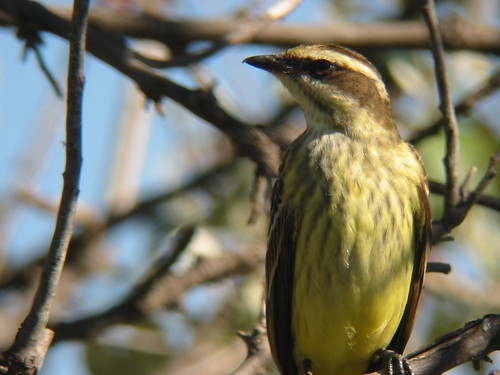
In September of 2006 there was a rare bird alert for a Northern Wheatear, the first ever of this northern and eastern European species to be seen in Everglades National Park. We drove right down and enjoyed great views. I was not into photography at that time, but I captured a shot of it with my 2 megapixel Canon A-40 point-and-shoot– fuzzy, but a nice souvenir (See: Chasing the White-Arse Bird)
We were not always so lucky. A Loggerhead Kingbird, the first of its species ever recorded in Florida, showed up in Key West in mid-March, 2007. We had prior plans to visit the Keys for a few days with my brother and his wife, and we arrived on March 25, 2007. On our way, we took our time sightseeing, arriving later than planned. The kingbird had been seen about an hour before we got there that afternoon, and we looked for the bird for a couple of hours, to no avail. That bird was never seen again!
Presently, we are enjoying the arrival of the spring migrants.
A Louisiana Waterthrush, an early migrant, was singing along the creek in Lippold Park in Batavia, Illinois: 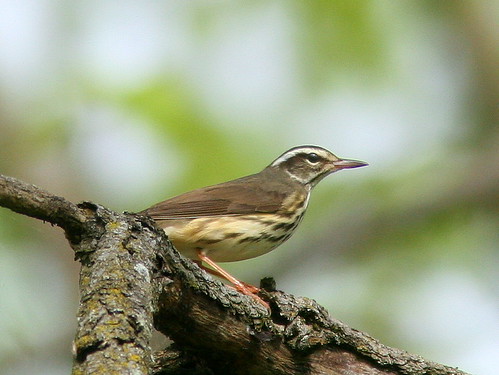
This week, we knew that “birder’s spring” had finally arrived, when we were greeted by some popular residents.
At Lippold Park, we saw our first Scarlet Tanager of the spring season…
…the first Rose-breasted Grosbeak…
…and Baltimore Oriole:
These female Brown-headed Cowbirds, though much maligned, struck a graceful pose in the branches:
A male cowbird displayed next to the females: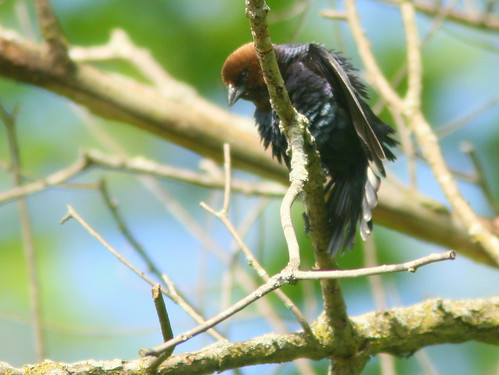
We also “discovered” a Bald Eagle nest not far from our home. We knew that it had been reported in the general vicinity, but thought it was probably in an inaccessible location. While walking in Hawk’s Bluff Park in Batavia, I saw a large raptor in at tree across a busy highway. The bino view made it clear that it was a Bald Eagle at its nest. We subsequently learned that this is the first Bald Eagle nest to be reported in in Kane County, Illinois, since before DDT was banned in the 1970s. Coincindentally, the nest near our Florida home is the first in Broward County over the same time span!
The lone eagle stands watch over the nest. This behavior suggests that the eaglets have hatched, and they do not require brooding by the parent, as they are now capable of regulating their body temperature, at least two weeks old: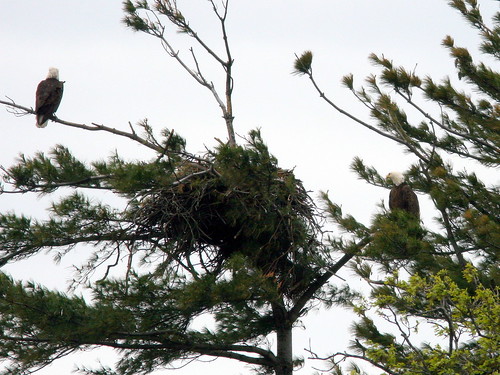
In a few minutes it was joined by a second eagle:
The other parent did not bring in any prey, and it also settled down in the nest tree:

At Jones Meadow Park near our home, in North Aurora, a Sora lurked in the marsh. Its bright yellow bill gave away its position in the shadows:













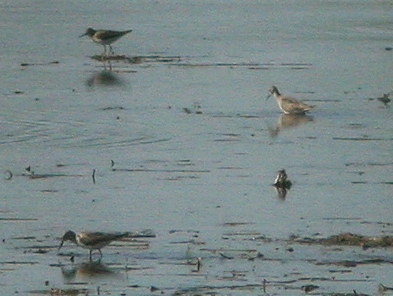
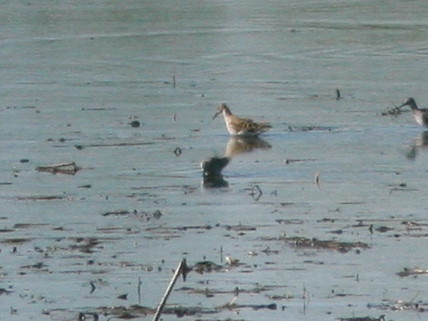
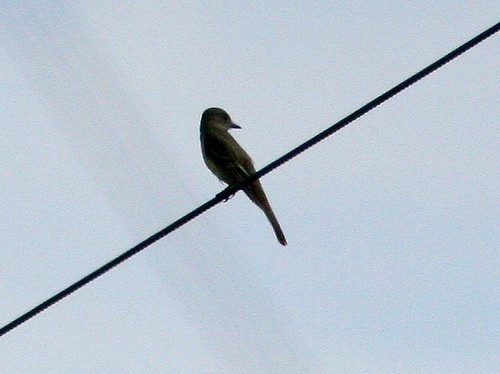
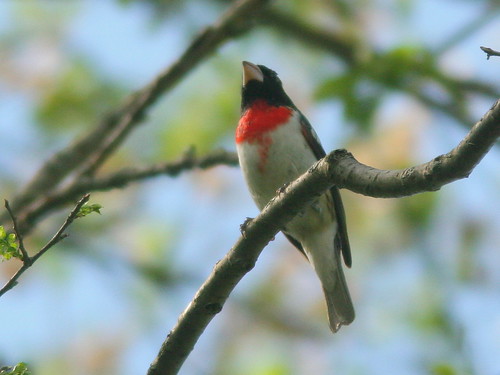
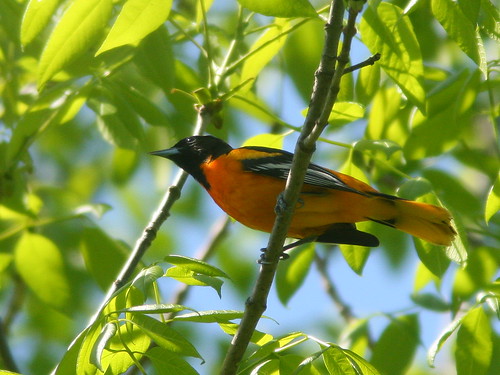


May 13th, 2010 at 9:07 am Congrats on the lifer Ken! Another great post with so many birds to see. The photo of the male Cowbird all fluffed up is super! Of course, all of your bird photos are excellent as always. Love that Waterthrush and the Piratic Flycatcher wow!